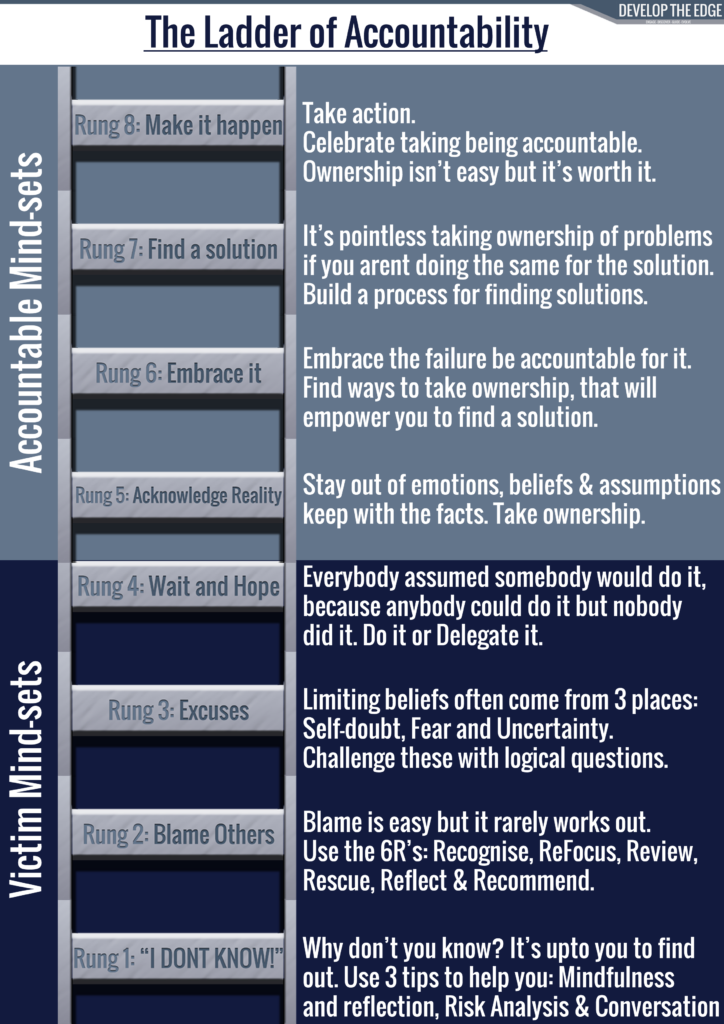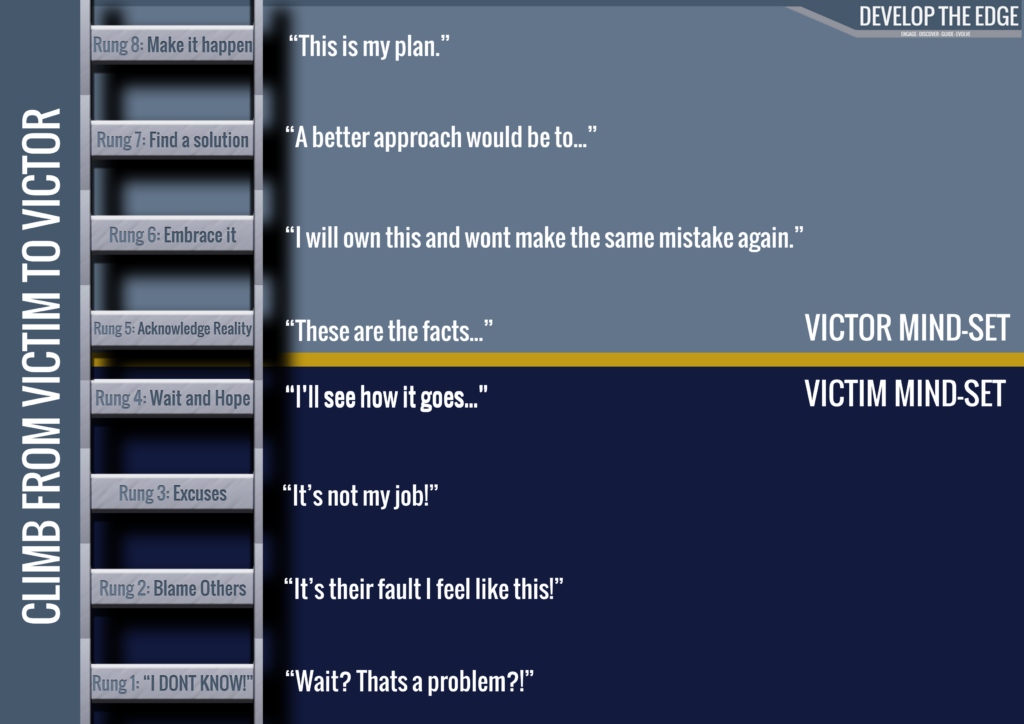
How would you like to become a:
- More vigilant problem solver?
- Better decision maker?
- Continually high performer?
- Highly motivated person?
- Highly satisfied person?
Well, together we are about to explore how accountability can drastically change the way you live your life, lead others and achieve your goals. We are going to Discover an amazing tool called the Ladder of Accountability and how it can transform your mind-set to make you unstoppable.
If you are thinking:

We’ve got you covered. Here’s the funny thing about accountability…when done correctly; it encourages others to take ownership, it gives you more time back, it feels empowering, you are more in control of your life and find more satisfaction in your choices. Not to mention that accountable people are more successful and are more positively viewed by their peers. The benefits of accountability are huge.
Accountability is about being responsible for success and silencing the voice in your head that wants you to be a victim. Don’t worry, we all have that Victim mind-set within our head from time to time and the temptation to listen to it can be strong because it gives people an excuse not to try. This article aims to help you fight the Victim mind-set by using an Accountable mind-set that aims to cut out the voices of “It’s not my fault”, “I don’t have the time” and any other thought you have about life happening TO you instead of happening BECAUSE of you.

Let’s begin to embrace accountability and take a look at how we can push back against the Victim mind-set and embrace freedom, success and empowerment through the Accountable mind-set
Why accountability matters
We hear people talk about accountability and we know that it’s important for getting things done – but the benefits of accountability are far greater than that. We are going to look at how accountability impacts; motivation, results, others, stress levels, time and fulfilment.
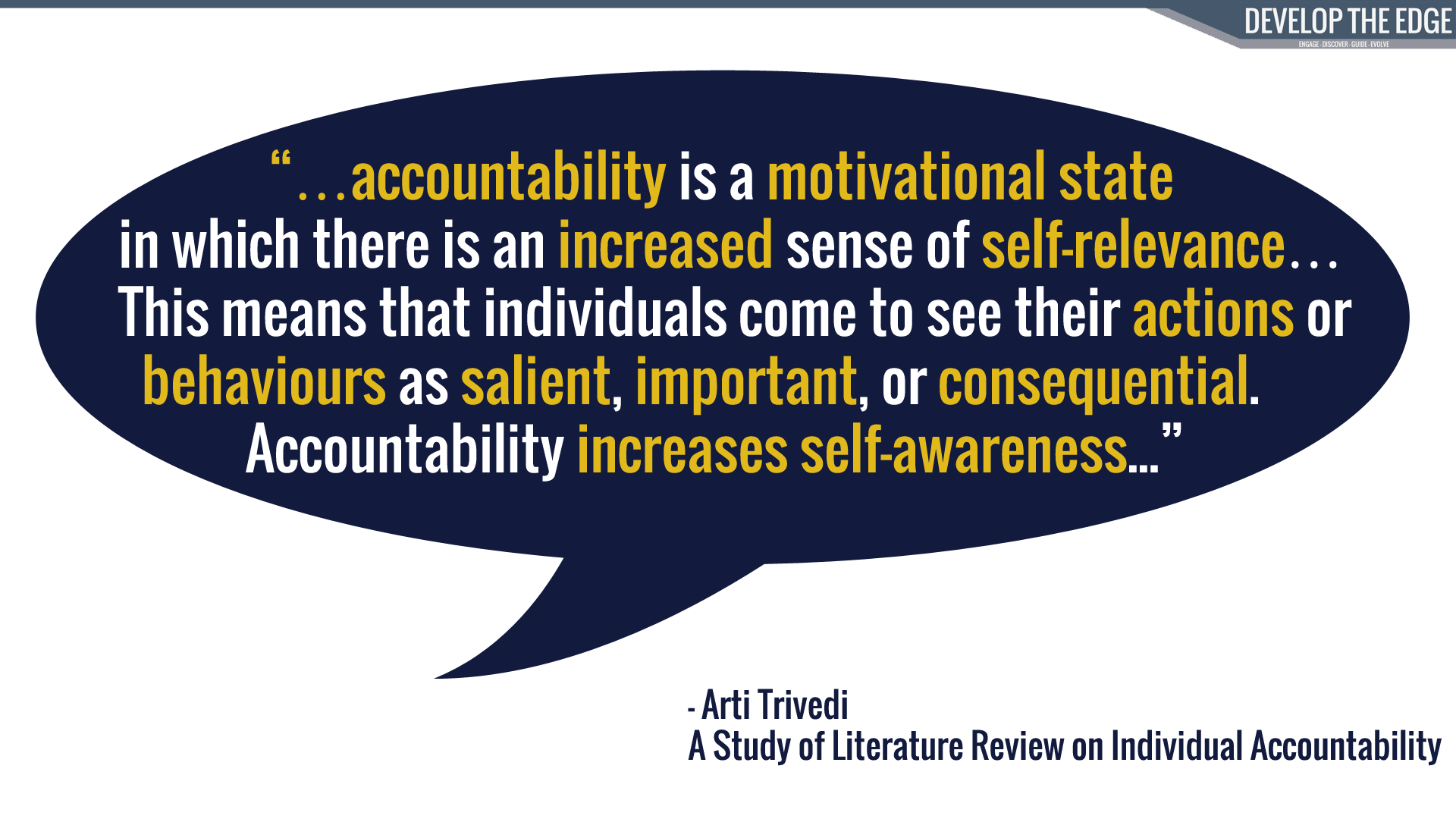
That’s right! Being accountable puts you in a motivational state. Think about anytime you have set a goal you are passionate about. You will know what actions you need to take, when to take them and you carry out these actions because you understand the purpose behind them.
Take a moment to consider the difference that these 2 options have on the way you feel:
- “Someone needs to help that person.”
- “I am going to help that person.”
Did the 1st one make you feel like a bystander, a victim or generally uninterested and detached?
Did the 2nd one make you feel more empowered, helpful, motivated and in control?
When you look around your house and see job after job, piling on top of each other – consider the difference in these 2 statements:
- “There is so much to do, why am I the only one that does anything around here?”
- “I’m going to make a list, get it done, ask for help and set a game-plan so we stay on top of things next time.”
Did the 1st one make you feel like a victim and that bad things in life happen to you? That there was so much to do because no one else pulled their weight? Did you feel overwhelmed and stressed?
Did the 2nd one make you feel empowered, resourceful, motivated and relieved?
This is the power of accountability. It’s a skill, one that comes with time and lots of practice. Fortunately, there is a simple tool you can use to help you identify whether you are in a Victim mind-set or an Accountable mind-set and take appropriate steps to take back control, feel more motivated, energised and calm.
Let’s get right into the Ladder of Accountability so we can create a much more useful and powerful Accountable mind-set.

The Ladder of Accountability was shown to me by my first Leadership mentor when I told him that operations wanted to see improvements in both the Quality and Productivity of my team but were not giving me adequate time to coach them to success. He immediately got out a printed image of the Ladder of Accountability and asked me if I was in a Victim mind-set or an Accountable mind-set. The answer was painfully obvious, I was in a victim mind-set. THEY wouldn’t give me the time, therefore my mission wasn’t possible. I was wrong, it was possible and with accountability, I took control and we smashed it.
The Ladder of Accountability has 8 rungs, 4 of which are Victim mind-sets; “I don’t know”, “Blame others”, “Excuses” and “Wait & hope.” The last 4 are Accountable mind-sets; “Acknowledge reality”, “Own it”, “Find solutions” and “Make it happen”. As you climb up the ladder, you become more accountable and begin to power your way through to success.

To understand the Ladder in more detail, we will need to explore each rung and discover how to climb to the top in order to achieve accountability and set ourselves up for success.
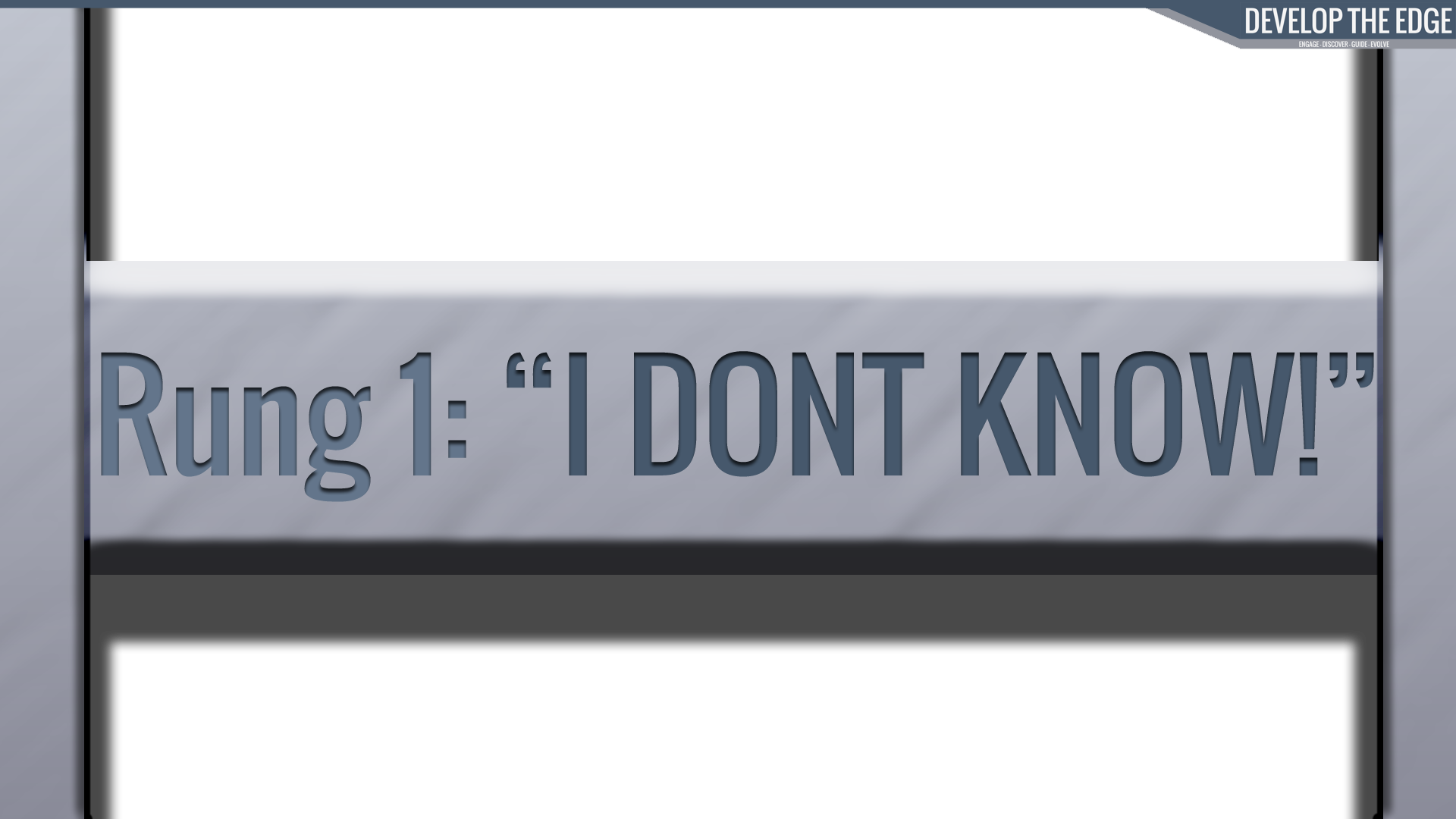
At the bottom rung of accountability is ‘I don’t know!” at this stage people simply don’t know that there is a problem. They are completely unaware that the problem exists or that something needs attention. We are surrounded by topics and situations we don’t know about – if we knew about them all we would likely have information overload. It makes sense then that we are all at this rung in some aspect of our lives – it’s up to you to identify it and decide if you want to take action.
This stage could be something simple as using an old process at work and saying “I did it because it’s what we’ve always done!” – when in reality the process is no longer fit for purpose. You may not have known it was an issue at the time, because you simply hadn’t taken a step back to consider the risks of taking the actions you did.
How many times have couples said to each other “How am I meant to know unless you tell me?” – A mix here of the stage “I don’t know” and our next stage “Blame Others.”
Before we move on to the next stage though, lets look at 3 quick ways that we can become more aware of the world around us and our levels of accountability:
- Mindfulness and reflection
- Risk assessments
- Conversations
1. Mindfulness is the state of being in the present and paying attention to the moment. When you are in the moment, you feel calmer and pay more attention to yourself and the world around you. This, alongside reflection may help you become more aware of the situations and problems you have been overlooking such as a partners body language, troubling situations or habit changes.
2. Risk assessments aren’t just for businesses. Have you thought about what would happen if giant ants from space came to enslave the earth? What would your emergency plans be for yourself and your loved ones? Yes – we got a bit crazy there but there is nothing wrong with creating an emergency plan in case of; natural disasters, burglaries, redundancy and so on. These are all things people can have a Victim Mind-Set about with questions such as “How was I meant to know?” or “What can I do about it?”
In reality though, there’s a simple answer: Risk assess and plan. Ideally do this proactively and before the event occurs but occasionally things happen and we have to react. The best way forward once you have a plan in place is to figure out how to stop similar situations occurring in the future.
Consider a simple 9 point Risk Assessment – Impact /Probability grid that may help you identify what risks you are best placed to focus on.

For example, if you were assessing the risk of being made redundant and you are in a secure job where it is unlikely you will be let go, you would start at the ‘Low Probability’ row in the above image. If that job was well paying and you have lots of financial commitments, we can agree that the impact of redundancy would be high and so you would need to go to the grid point: Low Probability/High Impact. This Grid axis takes us to a “Medium” risk level as outlined below:
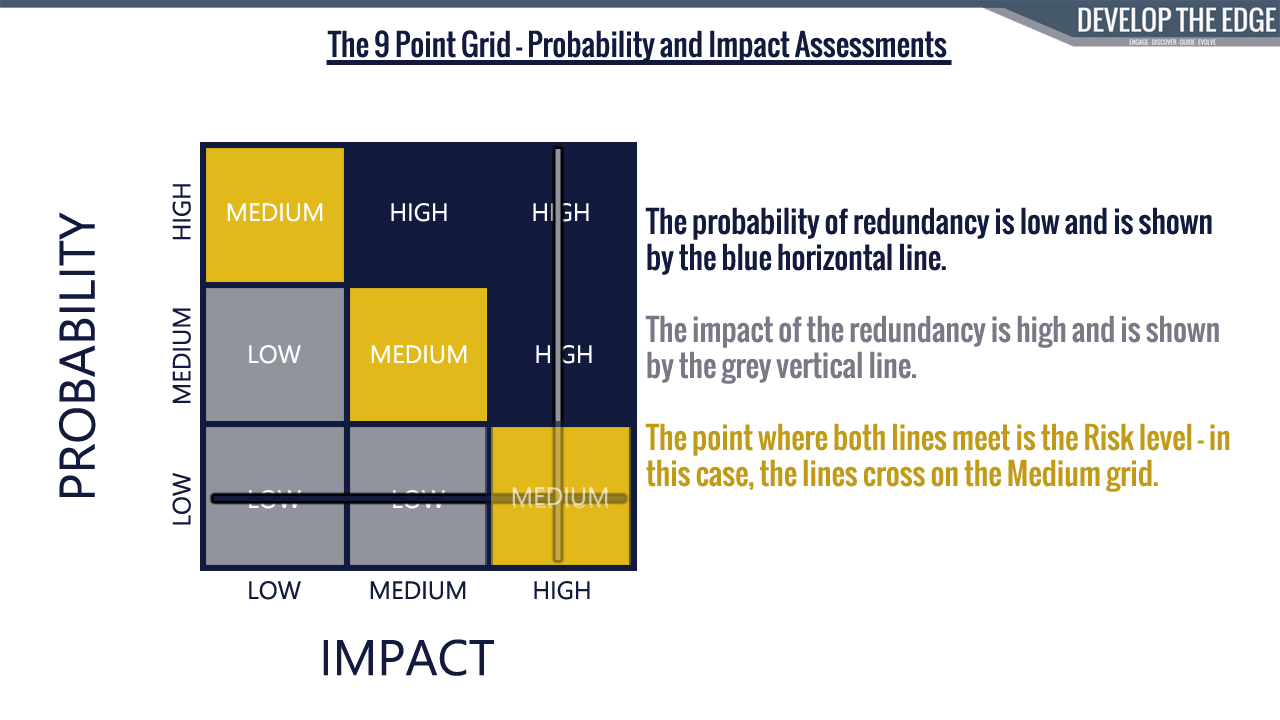
Something to create a plan for but not immediately stress over. If however, you didn’t have financial commitments and had lots of savings then the impact could be considered “Low” making this a Low Probability/Low Impact event, taking us to a “Low” risk level. It’s a good idea to have something in place still but even just to be aware of it and the potential impacts is a start.
3. Conversations are essential in life, they work wonders for accountability too. By talking to others, you are understanding their perspectives and they will likely talk to you about potential situations you were not aware of. You will also be able to pick up where you both are on the Accountability Ladder by the words being used.
Next time you hear yourself say: “I had no idea!” or “How was I supposed to know?” – recognise where you are and figure out WHY you didn’t know and how you could ensure you positioned yourself in a place of knowledge going forward.
With a good understanding on how to combat the ‘I don’t know’ rung of the ladder, we can begin to climb the ladder and get to the next Victim stage: Rung 2 – Blame Others.
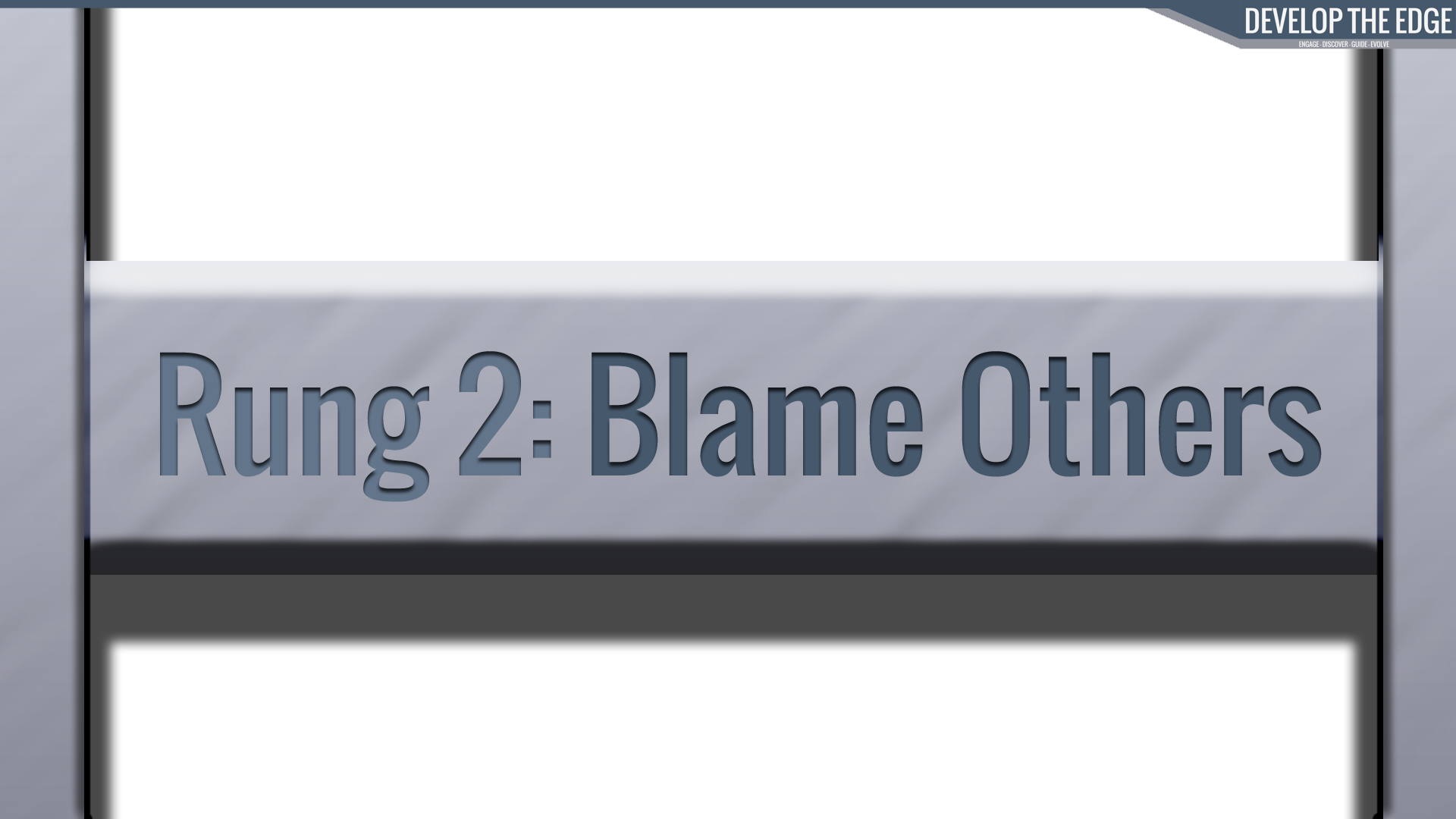
This is the phase where people want to shift the uncomfortable spotlight from themselves onto someone else. Whilst this can temporarily ease the pressure, it doesn’t make you feel better in the long run, it doesn’t get us to a solution faster, it damages relationships and it can make us feel guilty and ashamed later on.
This stage is a bit like the Stanford Marshmallow experiment – where children were given the choice between 1 immediate marshmallow or 2 marshmallows if they waited for a period of time. The study was to test instant gratification or delayed gratification. Like the experiment, you have 2 choices:
1. Cast blame for the immediate spotlight to be off of you (1 immediate ‘reward’)
or
2. Be accountable, explain what you could have done differently and find solutions going forward (2 much more satisfying rewards).
So before you go to cast blame on someone else, ask yourself whether you are choosing to take 1 or 2 marshmallows today?
To drive the importance home, here are 2 further points to consider:
- In follow up studies, they found that the children who had waited and taken 2 marshmallows were more successful in life.
- Blaming others in no way guarantees you that the spotlight will come off of you. In fact, you will likely develop a reputation for it, be considered untrustworthy, lose relationships and be even more likely to be considered responsible for the failure. People catch on quickly so don’t be known as the person that blames the world, make it known that you own issues and take action to get results.
In the words of Extreme Ownership Authors Jocko Willink and Leif Babin:

So how do we stop blaming others and start being more accountable?
Here are the 6R’s that we formulated based on research and over a decade of experience as coaches:
 Step 1: Recognise
Step 1: Recognise
You have to be aware of yourself when you are mentally or verbally placing the blame on someone else. Catch yourself doing it, stop the behaviour and move on to step 2.
Step 2: Refocus
You are now aware that you were about to cast blame on someone else. Take a breath and quickly scan why you were about to do that, you might find the reason you are responsible for the issue. Don’t dwell too much here right now, we need to refocus on the next step – Review.
Step 3: Review
What were you or are you accountable for? Find a way to be accountable for what’s happened.
For example:
- A colleague had 100% responsibility for a project but didn’t deliver? How could you have changed that? What support could you have offered? Could you have offered support in a different way? There are countless ways to make yourself accountable for something that at first doesn’t seem like it should be your responsibility.
Find out what you were accountable for, own it and be vocal about it. Chances are, this mind-set and mentality will help others become accountable too.
Step 4: Rescue
There is no point in placing the blame anywhere, even on yourself if you are not going to do anything about it. Work on fixing the immediate issue at hand. This level of ownership and responsibility will likely be admired by your peers and people up the chain of command as well.
Step 5: Reflect
We have fixed the issue at hand, all that’s left to do is reflect on why mistakes were made, how to improve ourselves, processes and teams to make us more efficient in the future.
Step 6: Recommend
All that’s left now is to make recommendations so that this doesn’t happen again. Up your accountability here and take some time to do a wider risk analysis to see if there is anything else that could benefit from being reviewed. This is where great learning opportunities come from, put processes in place to ensure your success in the future. Working with a team here helps build future accountability so consider facilitating a session on the best way forward.

Here are 3 common reasons people pass blame, why they don’t work and what you can do about it:

With the realisation that blame is actually our enemy other than our friend, it’s time to take the next step up the ladder. This rung is called Excuses.

As coaches, we hear excuses all of the time, such as:
- “I can’t!”
- “I don’t have the time!”
- “No one is supporting me! What if I fail?”
- “I cannot do this on my own!”
- “This is too difficult, nobody could do this!”
- “Of course THEY did it, they had support!”
People that say these kinds of things don’t tend to recognise them as excuses, they think they’re legitimately unmovable obstacles. As coaches we tend to call them ‘Limiting Beliefs’ and it’s something we are very good at challenging, reframing and helping people overcome.
A limiting belief is an assumption you hold about yourself or your situation that isn’t actually true. It’s our job as coaches to challenge this thought process through questioning and curiosity. We know that Limiting Beliefs often come from 3 main places: fear, uncertainty and self-doubt.
Once you have identified where these excuses or limiting beliefs are coming from, you can start to question your thought process on them. Taking a few of the above examples, we will identify where the limiting belief has come from and then look at some sample questions you can use to challenge them.
“I can’t!”
Where does this come from?
- Self-doubt.
What questions could challenge this limiting belief?
- “Really?” Followed by silence.
- “What’s the specific reason you can’t do it?”
- “Is there anybody that could do it?” followed by “How would they do it?”
“I don’t have the time!”
Where does this come from?
- Uncertainty
What questions could challenge this limiting belief?
- “How could you make the time?”
- “What is stopping you from making the time?”
- “How much time do you think it would take?” Followed by “Could you split this into smaller chunks?”
- “Who would have the time?”
- “Why isn’t this important enough for you to make the time?”
“No one is supporting me! What if I fail?”
Where does this come from?
- Self-doubt and fear
What questions could challenge this limiting belief?
- “What makes you think you need support?”
- “What support do you think you need?”
- “Could you ask for help?”
- “What makes you think you will fail?”
- “If you do fail, what then?”
It’s important to listen out for limiting beliefs and excuses. By effectively challenging them you open up the door to accountability and success. Once we have successfully navigated the excuses and limiting beliefs, the next rung on the ladder is Wait and hope.

This is the last of the Victim mind-sets on the Ladder of Accountability. Whilst it isn’t blaming others, making excuses or being unaware of the situation, there is still a clear lack of accountability that needs addressing.
At this stage, the person simply waits and hopes someone else will do it. If we are being honest with ourselves here, there is at least one thing that you have left and hoped someone else would do. The problem here is that if everyone waits for someone else to do it, no one would do it! Here is a short video that explains the story: Everybody, Somebody, Anybody, Nobody:
Wait and Hope in work can be seen as a cultural lack of accountability. Everybody assumed somebody would do it, because anybody could do it but nobody does! This can push us right back down to the Blame game on rung 2 as we start pointing fingers at other people who should have done it.
Do not waste your time and energy falling back down the ladder. Here are 3 quick and simple ways to get passed Wait and Hope:
- Do it yourself.
- Explain to someone why you cannot do it and ask for help.
- Offer to take work from someone else so they will have the time to do it.
Just like that, we have taken accountability and either taken control of the situation ourselves of empowered someone else to complete the task. Of course, ownership is about owning the task completely, so even if someone else says they will do it, find a way to be accountable for the task still – check in on the person, see if they are getting on okay or if they need support. Delegating work doesn’t make you less accountable, you should still be responsible for the end result.

With strategies in place to deal with the 4 Victim mind-sets, it’s time to begin the climb into the Accountable mind-set. Give yourself a pat on the back here, celebrate and enjoy the moment. Accountability is hard but it is worth it. Ensure you celebrate and reward yourself for taking accountable actions.

Acknowledging reality is where we are able to put all of the petty and unhelpful Victim mind-sets to one side. This can be a difficult step for our ego to take but it’s a necessary one to become an accountable and successful person. When you acknowledge reality you strip away all of the noise, beliefs and assumptions that were gathering on the first 4 rungs. You look at the facts of the situation, where you are, the facts that led to the problem and understand that something needs to change.
Let’s understand why acknowledging reality is important:
- Reality gives you an honest view on what’s happened and why
- This lets you get to the root cause of the problem instead of fixing symptoms
- Often the sting of acknowledging short comings can stop you from making the same mistake twice
- People around you will see you truly want to understand and fix the problem
Once we understand how important acknowledging reality is, we need to establish how much of what we are seeing is raw factual data and how much of it has been interpreted by ourselves through our beliefs and assumptions.
For example, if we revisit the scenario where jobs are piling up around the house, our view will be distorted by our beliefs and assumptions:
“The other person doesn’t do anything around here.” – Belief
“They are just lazy!” – Assumption
“They don’t care about me or the house.” – Assumption
“I am not valued here.” – Belief
Wow, that spiralled quickly out of control! We need to break away from these beliefs and assumptions and get to the facts. Here are some questions that may help you dive down into the concrete evidence:
- Which of my beliefs are impacting these thoughts?
- What assumptions am I making and why?
- Am I using all of the available data or am I being selective with it?
- What are the core facts of the situation?
After thinking about these questions, we may come to the below conclusions:
There are lots of jobs that need to be done.
The jobs I do are X, Y & Z.
I don’t know what jobs the other person does, I should probably find out.
I do not factually know why the house has so many outstanding jobs right now.
I do not have any proof that says they do not value me or the house, it’s just the way I felt.
What I do know is that we have a lot to do, we need a game plan to fix the problem and have a strategy for the future.
With these simple questions, we have moved from quite an emotional state to one of a rational and calm mind that is now able to take ownership and find solutions. Living in the facts and acknowledging reality is a powerful skill to develop. Keep working on it every time you feel your emotions getting the better of you.
Here are 3 more great questions we have highlighted in our previous article on the GROW model. They use a method called ‘Chunking down’, which is when you take an emotive statement and ask a question designed to break the emotional pattern and focus on a factual and logical answer.
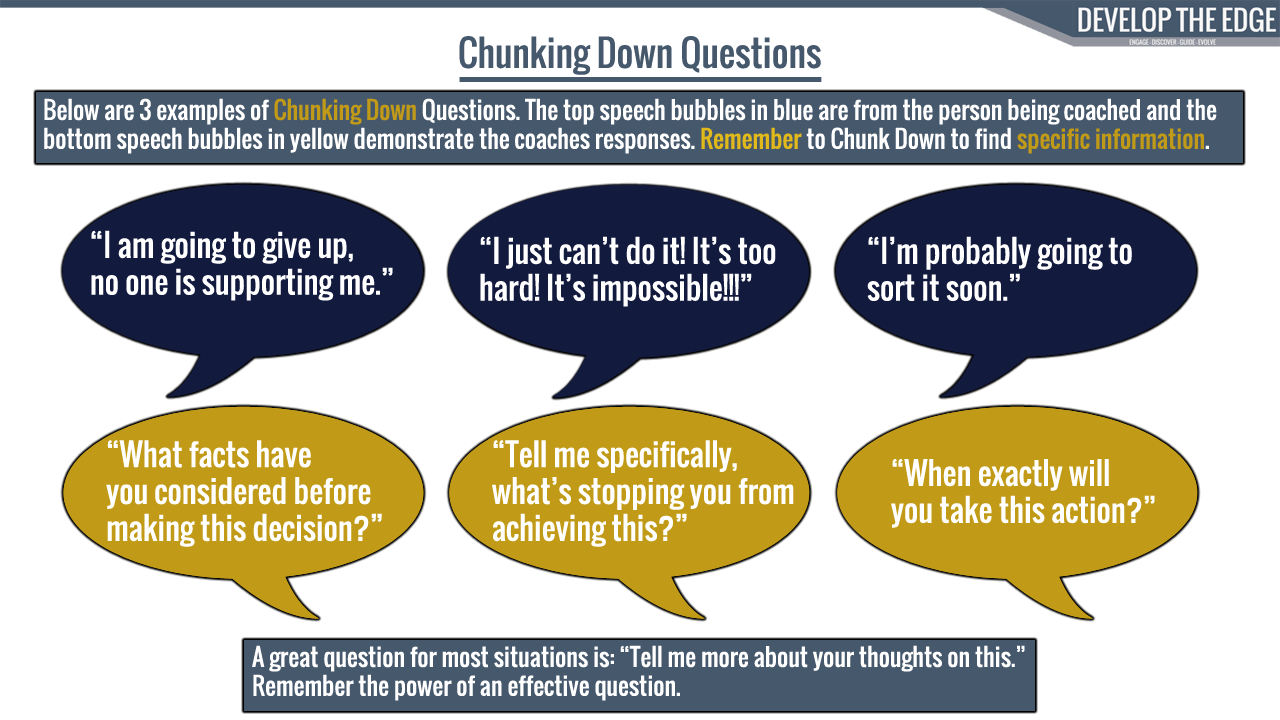
If you want to know more about the Grow model, our article on it is here: https://www.developtheedge.com/get-up-and-go-with-the-grow-model/
With an honest view on the situation, it’s time to climb to the next rung of the ladder –Embrace it.

This is the stage that can be quite difficult as you now have the facts, it’s time to embrace your responsibility for what happened. When you own the mistake or problem. You are more determined to solve it. This stage is a constant battle with your ego as it pushes back from taking blame and wants to shout about all the things it has done not the 1 thing it hasn’t. The problem is, the 1 thing you didn’t do is the cause of the problem. There is no point running a 100m race and stopping at the 99th meter.

As Whitmore said, ownership leads to motivation and thus results. If you take ownership of the problem, you will be driven to find a solution.

We are going to give you a scenario that may be difficult for you to take ownership of.
Work out how you could make yourself accountable for the problem, what mistakes did you make here that lead to the failure of the project?
- A project came in to the team from your client, one of your colleagues eagerly put themselves forward for the task and your manager happily gave it to them. In your weekly meeting your manager checked the progress of every team member’s projects and your colleague always said everything was going great. Whenever you caught up with your colleague in meetings or the breakroom, they seemed confident in their work and abilities. They always seem on top of everything. On the day of the deadline your colleague told you that they were nowhere near completion and that they had been lying when they said everything was great. Due to the project not being completed on time, client ended up cancelling all contracts with your team, losing the company a lot of money and damaging its reputation.
- List all of the ways you can take ownership of the projects failure before continuing with the article.
If you are struggling with this one, watch this 15 minute video by Jocko that may give you a few ideas.
Once you have answered the questions, the article continues below the video.
Once you have worked out how you can take ownership of the situation, think back to a time where you felt like there was no-way you could have been accountable for a problem or situation – when it was 100% someone else’s fault. Take a different perspective on it now and think about what you could do to change that – what could you make yourself accountable for in that situation?
Now that we have embraced our accountability of the problem, the next step is vital – Find a Solution.
It’s pointless just taking ownership of a mistake, you have to learn from it and try to fix it. Consider the immediate way forward for the problem or situation and how you will take responsibility for it.
We also need to learn from our mistakes, so with your clear view on what went wrong from the Embrace it stage, start to come up with solutions that will stop it happening again.
Consider the last scenario we went through together, where you colleague took on a project which failed and cost the company both income and reputation. Review your list of mistakes that you are accountable for and write down what you will do differently next time to ensure that future missions will be a success.
You can also do this with your personal scenario.
Ariana Glantz has a TED talk about finding solutions where she acknowledges how scary it can be to start looking for solutions, especially if we don’t initially think we have the tools or confidence to do it. To help overcome this, she has created a simple 5 step process for generating the way forward. We have broken this down for you below but the video is here:
- Mindset
Make being solutions minded part of your identity. Before sitting down, remind yourself that you are a person that is focused on finding solutions. If you brain keeps drifting back to the problem, redirect it to the solution.
- Structure
Create your own process for problem solving, whether it’s a start to finish approach or is more about idea generation, know what works for you and make tweaks to it along the way.
- Question
Clarify the problem by asking questions about it – there’s no point creating a solution if you haven’t explored the problem – your solution may be wrong! Question colleagues, friends and subject matter experts for their opinions and ideas.
- Practice
Finding Solutions is a skill that takes time and practice, so use every problem as an opportunity to try out your new process.
- Patience
Be kind to yourself and others, learning a new skill or just navigating through problems can be a challenging time. Support yourself and others.
With a Solution in mind, it’s time to climb up to the final rung of the ladder Make it happen.
You’ve done the hard work, you have put your ego to the side, admitted accountability, embraced the feelings and consequences that come with making mistakes and you have generated a way forward. Now all you need to do, is take action.

As you have made the decision to be accountable, this step should be fairly easy. People who feel accountable are much more likely to take appropriate action to get the desired results. Take time to celebrate what you have achieved here, taking ownership is not an easy road but it is one that will see you succeed, it is one where you will become a leader and inspire others to be more accountable.
The next time you make a statement or have a thought about a problem or situation, take a minute to consider where you are on the Ladder of Accountability. Think about what steps you need to take to move from a Victim Mind-set to an Accountable-Mind-set in order to succeed.
Conclusion:
There are 8 rungs on the ladder of accountability; “I don’t know”, “Blame others”, “Excuses”, “Wait & hope”, “Acknowledge reality”, “Own it”, “Find solutions” and “Make it happen”. You have the choice on whether you want to have a Victim mind-set or an Accountable mind-set. Being a Victim is easy in the short term but can cause long term damage to your mentality, relationships, skills and abilities. Being accountable may be difficult in the short-term but the long-term pay offs are massive. You become more passionate, more dedicated, more solutions focused, more satisfied, better at solving problems and inspirational to others. In fact, Arti Trivedi in his paper A Study of Literature Review on Individual Accountability, said this:

That brings our article on the Ladder of Accountability to a close. We have added the following resources to the bottom of the page:
- A FREE 40 Page Guidebook to help you and others become a Victor instead of a Victim
- 2 x Ladder of Accountability Hand Outs
- Ladder of Accountability 1 page guide
If you have found the article valuable, consider sharing it with others by clicking the Social Media icons below.





